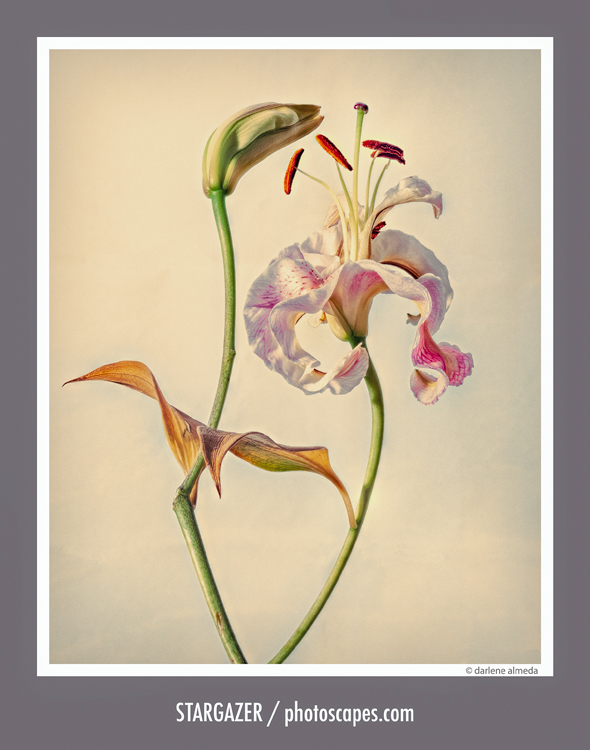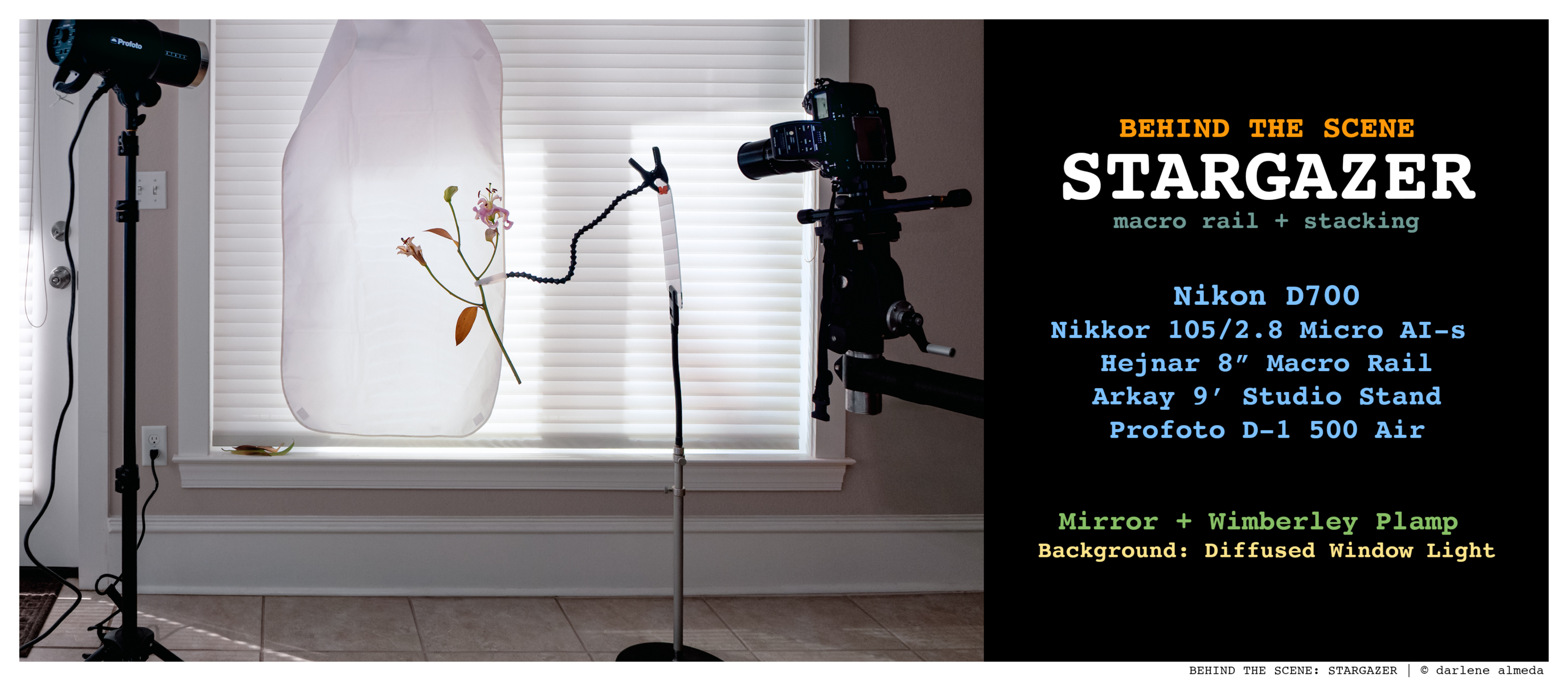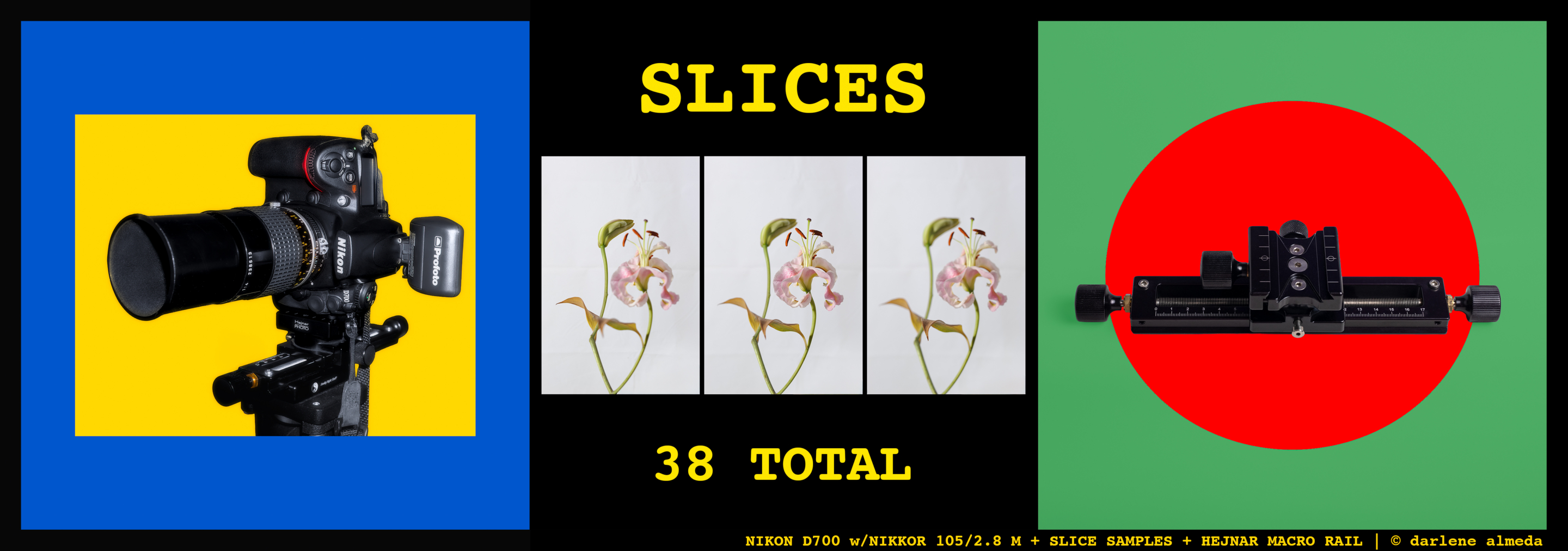Camera: Nikon D700 Lens: Nikkor 105/2.8 Micro AI-s Digital: 12.1 MP [36x24] CMOS Software: Adobe Lightroom
Location: Studio Date: 2014 Lighting: Strobe + Reflected Genre: Still Life
Stargazer is the kind of image that blooms when cabin fever creeps in or when the well of inspiration runs dry.
As I shared in an earlier post, Finding Inspiration in Simple Things: Overcoming Creative Slumps, quiet lulls come for us all. I’ve been lucky. Years ago, when I made this house my own, I added a studio—a space designed with light in mind and with the thought that, someday, it might become a sunroom for someone else. I built it with the quiet hope that light would always find me there.
I think back to my Brooklyn apartment, the one I had after landing my first job as a commercial artist. The space was small, but wonder doesn’t need much room. A single window where sunlight poured in at just the right hour. A kitchen chair with a straight back became my backdrop holder; its seat, my makeshift tabletop. That was my classroom. That’s where I first learned how to see—how light could shape mood and how even the simplest setting could awaken the creative spirit.
Photography school offered me the space—and the discipline—to learn how to maneuver one light, bouncing it with reflectors and mirrors like a quiet dance. But they didn’t hand you instructions. Instead, they gave you a tiny studio space tucked away in the basement and left you to figure it out because that is how it is done.
If it weren’t for my studio mate, John, and his steady hands, my sawhorses might have collapsed under the weight of my first attempts to build them. That was where I discovered a new kind of creativity: set construction.
Back in the days of shooting 4×5 transparencies for product work, we built everything ourselves—walls, windows, and surfaces that mimicked reality. Those lessons stayed with me. Even now, they echo in the simplest images I make, like Stargazer—titled after the lily itself, yet also a nod to those quiet beginnings when crafting a world from scratch was just part of the art.
STARGAZER BEHIND THE SCENE
One Sun, One Light
Take a look at that simple setup above. The main light—what some call the key light—is a Profoto D1 500 Air. The “Air” means freedom: no cables, just a built-in transponder that responds when the small black transmitter, slid into the Nikon’s hot shoe, sends its signal. Press the shutter, and the light responds like a sun summoned on cue.
But my history with strobes stretches far beyond Profoto. It goes all the way back to Novotron and Speedotron—those heavy, humming power packs we used to haul around, their thick, battered cables as knotted and wild as jungle vines. You carried your light like it had weight in the world because it did.
Over time, I’ve come to prefer simplicity in lighting. One light, like a small sun, is often enough if the subject allows. I’ll coax a little more life into the shadows using just a mirror or a reflector—bending light softly, sculpting with care.
If I want a high-key set—bright and airy, mostly white—I’ll bring in more control, more strobes, more precision. I’ve done that hundreds of times, especially for portraits of children and families. But whenever I can, I come back to the quiet magic of one light and the patience to guide it gently.
Stargazer began as a grocery store flower, delicately held in place by a Wimberley Plamp—its long, flexible arm clipped to the studio mirror. I positioned it there with intention, bending light just enough to touch the shadows the main light cast onto the subject, but not enough to erase them entirely. I wanted some mystery to remain.
The background is nothing elaborate—just a white, semi-translucent piece of material draped from an out-of-view roller. No need to unfurl the whole backdrop when a small slice of light-toned fabric will do the job. Efficiency has its own kind of elegance.
The Nikon D700, paired with the classic Nikkor 105mm f/2.8 AI-s Micro lens, sits on a Hejnar macro rail, itself secured to a Majestic head atop an Arkay studio stand. I favor wheels on most studio gear—camera and light stands alike—because movement, like light, should flow effortlessly when shaping a scene.
From the camera’s perspective, the Stargazer sits squarely in frame. A second flower leans in from the left, but I’ve chosen to exclude it—letting the focus stay where the light falls and letting the composition breathe.
NIKON D700 w/NIKKOR 105/2.8 M + SLICE SAMPLES + HEJNAR MACRO RAIL
How It Was Shot
Stargazer is the result of multiple images combined—a process we now casually call focus stacking. Back in 2014, when this image was made, the technique wasn’t nearly as mainstream. But to me, it felt like one of the quiet gifts of digital photography: the ability to gather sharpness across planes, to build clarity frame by frame.
The software I used was Zerene Stacker. At the time, it felt ahead of the curve—more refined, I thought, than the Helicon Focus I use now. It handled the frames gracefully, layering them into a single, seamless image.
Word traveled fast. A camera club in North Florida reached out, curious about this unfamiliar method. They asked me to speak, and I happily agreed. I’ve always loved sharing what I learn—especially when it comes to photography, where even the most technical parts can feel a little like magic.
Once the stacked image was complete, I brought it into Lightroom for post-processing. The clean white background didn’t quite fit the mood I had in mind—I wanted something softer, something with a touch of age, like the faded edges of a memory.
Through careful color grading and the help of whatever NIK Color tools were available at the time—including their white neutralizing filter—I began to shift the image with an antique-ish touch. I’ve always enjoyed the dance of adding color and then pulling it back. White neutralizing helps me strike that delicate balance—where tones whisper instead of shout.
Closing Comment
Creating Stargazer using just one light and a mirror takes me back to my roots in photography. I find myself sitting here, remembering the light streaming through that Brooklyn window and the quiet excitement I felt for all the possibilities that lay ahead.
If I can leave you with anything from this post, it’s this: when you’re in a creative slump, you might just find magic in the simplicity. Remove the distractions. Keep your gear to a minimum. Sit with the object that’s calling to you.
Follow the light. Become the light. And trust yourself enough to go with the flow.



